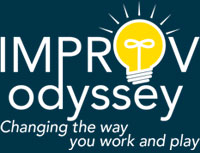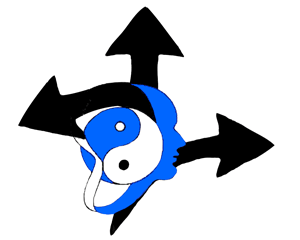The Genius of Preoccupation
Spolin’s pathway to the Unknown
The [Spolin’s Theater Games] exercises are artifices against artificiality, structures designed to almost fool spontaneity into being–or perhaps a frame carefully built to keep out interferences in which the player waits.
Important in the game is the ‘ball’ — the FOCUS, a technical problem, sometimes a double technical problem which keeps the mind (a censoring device) so busy rubbing its stomach and its head in opposite directions, so to speak, the genius [spontaneity], unguarded ‘happens’. –Tung, in Film Quarterly
Viola Spolin intuited an important principle while developing her ideas of improvisation — Preoccupation. Preoccupation games involve paying attention to more than one focus. By integrating two or more disparate activities in a game the whole self is activated and a doorway to the intuition or X-area[i] opens up.
She found a technique that is now being re-examined and articulated in the book IMAGINE by Joshua Lehrer. One of the ideas the book talks about is that often, single-minded, constant focus on a problem results in pedestrian thinking and may actually prevent a leap of the imagination that leads to inspiration. Some very successful innovative companies ask their researchers to observe the 15% rule, developed at 3M. Work on a problem 85% percent of the time then and devote a certain amount of time (15%) to completely unrelated activities. Google calls it Innovation Time Off. Somehow it became evident in the study of creativity that inspirational thinking occurs when the mind is both stumped and diverted and relaxed.
Spolin’s games and exercises do just that. Even though they are designed to acquire requisite skills for acting and theatrical improvisation, often they can be doorways to one’s true creative potential. With the proper coaching they are doorways into the realm of the intuitive – the area where inspiration is born. That is why they are so transformational.
The creative act transforms the one who is in it. – Viola Spolin
The idea of preoccupation sets up an instant problem. By pitting two or more disparate skills against each other often results bursts of original work for an actor. When you focus your attention in one area while compounding it with another unrelated focus, something amazing happens.
What that is cannot be predicted or explained, but it is one of the tenets of Spolin Games. Viola called it evoking the genie. One thing is certain though; it brings the individual into a state where one can transcend the bounds of the traditional tried and true ways of thinking.
For example in the game of Contrapuntal Argument, one develops ideas or arguments based on what one already knows and that is combined with forceful, non-stop arguing coupled with simultaneous listening. On the face of it, the game teaches presenting your ideas unselfconsciously, extemporaneously and persuasively. It is also a listening game – Both good skills to have.
This is how the game is played: Two people sit across from each other usually over a small table. (Viola said it helps as a support) and select a topic to argue about or two different topics to pitch to each other. The game is divided into three parts:
Part 1: Each player must pitch his/her idea to the other. Both speak simultaneously trying to penetrate the argument of the other player without letting the other player derail or penetrate his/her own ideas. Each player must continue to talk. Points off for pauses, hesitations, or repetitions. (Audience can keep score)
Sidecoaches to use are things like; Pierce/Penetrate your partner’s argument! Put forth your ideas! Keep talking! Make your points!
Part 2: Each player continues to advance their own ideas or argument by forcing the other player to repeat, pick up or use something from the other player’s diatribe, again continuously advancing their ideas.
Sidecoaches to use are things like; Penetrate! Listen and Speak at the same time! Insert your idea into his argument! Keep going!
Part 3: Each player tries picking up from the other player ideas or words that support that player’s point of view. They are to use the word or phrase from the other player and incorporate it in their own argument.
Sidecoaches to use are things like; Penetrate! Listen and Speak at the same time! Use what you hear! Keep going!
The subtitle of Contrapuntal Arguments is Transforming Points of View. It is an interesting thing to watch what happens when we strenuously argue our own ideas and do this progression.
Most people when arguing stay at level one. It is usually a wall of words and it is difficult to allow anything in because you are so attached to your ideas and your way of expressing them.
Some more skillful arguers can get their points across and score on their opponents in round two. A well placed word or phrase or interesting way of saying something can come out of this.
But when both players begin to hear and use the other person’s ideas and incorporate them into their own argument, things change. It stops being an argument! It becomes a dance of ideas. When this exercise is successful, each player transcends their own point of view and both ideas merge into a third thing – True collaboration! And beyond that, a surprising voyage to new ideas and deep levels of connection!
When I first did this exercise in Viola’s class, I remember vividly arguing the value of creative cooking while my partner argued that the highest form of creativity was ballet.
In round one, it was impossible to even hear one word my partner said as I barraged her with the diversity and complexity involved in cooking. I heard nothing of what she was saying. I may have scored a few points by stopping her or getting her to hear ME. I actually don’t remember.
In round two I heard her talk about how dance was something you didn’t need tools for as in cooking. You just need your body. I mentioned something to the effect of food is the fuel of the body and therefore more important than dance and in some cannibal cultures our bodies were food!
In round three all I can remember is we were still arguing, I remember rising to my feet and shouting Bread is LIFE! At the same time, she was gracefully gesticulating and using my gestures as dance moves. We were motioning in such a way that it became a sort of ballet. By the end were standing, swaying and singing the praises of motion and movement, claiming food and dance are interdependent and intertwined and that both expressions are vital to life!
I was so preoccupied by the focus of the game that not only did I make a great argument, but I came up with ideas I had no idea were related to my subject.
In the end, I was so connected to my partner that my argument turned into a dance!
I don’t remember the details of my ideas on food (and it doesn’t really matter), but I will never forget that argument. I was transformed by it and was channeling some kind of force I cannot explain or contact in any other way, than by playing.
Postscript: I think many improv teachers have not seen the potential in games to generate this level of … , nor are they aware of the potential opportunity of transformation in some of Viola’s games.
Many improv games in use today may have been based on Viola’s work, but were not fully understood by the majority of players and coaches. It was only through my own experience in being coached by her and watching her coach others that I saw what she was after. If you read her work closely, it is there in her book. But it must be both witnessed and experienced, then integrated into the work.
In missing this potential, many of Viola’s games have been re-tooled and developed for quick wits and verbal acrobatics. Many games invented by others since mostly develop ‘the head’ which means to say the use of old information in novel ways. Games like Freeze Tag, Ding, Party Quirks and the like miss the point of transformation at the heart of all of Viola’s games.
Most new improv games operate on a fun level and therefore have some intrinsic value. Fun is a primary good. I must admit I have seen these games used to illustrate a point, develop a skill, generate cooperation and create some funny situations and that is fine.
Most new games help us cope with some things like quick retrieval of information, and a respect for accepting ideas and building upon them. But there’s that ephemeral, will-o-the-wisp – transformation that rarely shows in the typical improv show. Or if it does, it is only by accident and not by design.
Viola’s work charted a course into that X area and many practitioners of improv do not understand what that is. And although she originally taught skills to prepare you for the stage, she was after something more. The unknown – X. I believe that was her ultimate goal.
[i] Viola believed that labeling something stops us from investigating it fully in new ways. She eventually saw that by overusing the word ‘intuition’ robbed it of the magic it represents. So she started calling it X. As in physics and mathematics X represents the unknown. That was what she was always after – the exploration of the unknown.


